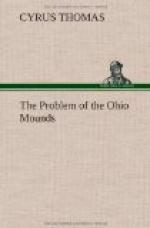As graves of this kind are common over the west side of southern Illinois, from the month of the Illinois to the junction of the Ohio and Mississippi Rivers, attention is called to some evidence bearing on their origin.
Hunter, who traveled in the West, says that some of the Indians he met with during his captivity buried their dead in graves of this kind.
According to a statement made by Dr. Rau to Mr. C. C. Jones, and repeated to me personally, “it is a fact well remembered by many persons in this neighborhood [Monroe County, III.] that the Indians who inhabited this region during the early part of the present century (probably Kickapoos) buried their dead in stone coffins.” [Footnote: Antiquities So. Indians, p. 220.]
Dr. Shoemaker, who resided on a farm near Columbia, in 1861, showed Dr. Rau, in one of his fields, the empty stone grave of an Indian who had been killed by one of his own tribe and interred there within the memory of some of the farmers of Monroe County. An old lady in Jackson County informed one of the Bureau assistants that she had seen an Indian buried in a grave of this kind.
It is doubtful whether Dr. Rau is correct in ascribing these graves to the Kickapoos, as their most southern locality appears to have been in the region of Sangamon County. [Footnote: Reynolds’s Hist. Illinois, p. 20.] It is more probable they were made by the Kaskaskias, Tamaroas, and Cahokias. Be this as it may, it is evident that they are due to some of the tribes of this section known as Illinois Indians, pertaining to the same branch of the Algonquin family as the Shawnees and Delawares.
That the stone graves of southern Illinois were made by the same people who built those of the Cumberland Valley, or closely allied tribes, is indicated not only by the character of the graves but by other very close and even remarkable resemblances in the construction and contents as well as in the form and size of the mounds; the presence of hut-rings in both localities, and the arrangement of the groups.
Taking all the corroborating facts together there are reasonable grounds for concluding that graves of the type now under consideration, although found in widely-separated localities, are attributable to the Shawnee Indians and their congeners, the Delawares and Illinois, and that those south of the Ohio are due entirely to the first named tribe. That they are the works of Indians must be admitted by all who are willing to be convinced by evidence.
The fact that in most cases (except when due to the Delawares, who are not known to have been mound-builders) the graves are connected with mounds, and in many instances are in mounds, sometimes in two, three, and even four tiers deep, proves beyond a doubt that the authors of these graves were mound-builders.




